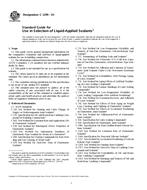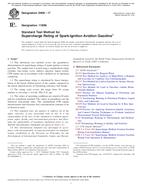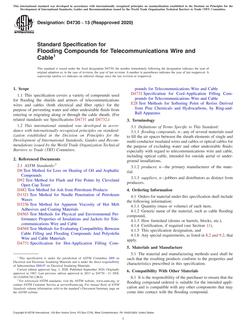1.1 These test methods cover the determination of the physical and chemical properties of ion-exchange resins when used for the treatment of water. They are intended for use in testing both new and used materials. The following thirteen test methods are included:
| Sections | |
| Test Method A–Pretreatment | 6-10 |
| Test Method B–Water Retention Capacity | 11-17 |
| Test Method C–Backwashed and Settled Density | 18-24 |
| Test Method D–Particle Size Distribution | 25-32 |
| Test Method E–Salt-Splitting Capacity of Cation- Exchange Resins |
33-41 |
| Test Method F–Total Capacity of Cation-Exchange Resins |
42-50 |
| Test Method G–Percent Regeneration of Hydrogen- Form Cation-Exchange Resins |
51-58 |
| Test Method H–Total and Salt-Splitting Capacity of Anion-Exchange Resins |
59-66 |
| Test Method I–Percent Regeneration of Anion Exchange Resins |
67-75 |
| Test Method J–Ionic Chloride Content of Anion- Exchange Resins |
76-83 |
| Test Method K–Carbonate Content of Anion- Exchange Resins |
84-91 |
| Test Method L–Sulfate Content of Anion Exchange Resins |
92-99 |
| Test Method M–Total Anion Capacity of Anion- Exchange Resins |
100-108 |
1.2 The values stated in SI units are to be regarded as the standard. The inch-pound units given in parentheses are for information only.
1.3 This standard does not purport to address all of the safety concerns, if any, associated with its use. It is the responsibility of the user of this standard to establish appropriate safety and health practices and determine the applicability of regulatory limitations prior to use. Specific precautionary statements are given in Section 10.8.
6.1 This test method covers the conversion of ion-exchange resins to a known ionic form and is intended for application to both new and used material.
11.1 This test method covers the determination of the amount of water retained by ion-exchange resins and is intended for testing both new and used materials.
18.1 This test method covers the determination of the backwashed and settled density of ion-exchange resin and is intended for testing both new and used material.
25.1 This test method covers the wet sieve analysis of ion-exchange materials.
33.1 This test method covers the determination of the number of milliequivalents of exchangeable hydrogen in a cation-exchange resin sufficiently acidic to split neutral salts.
42.1 This test method covers the determination of the total number of milliequivalents of exchangeable hydrogen in a cation-exchange resin.
51.1 This test method covers the determination of the percentage of ion-exchanging groups in a cation-exchange resin that is in the hydrogen form.
59.1 The test method covers the determination of the total number of milliequivalents of exchangeable chloride in a test method anion-exchange material and also the number of milliequivalents of exchangeable chloride capacity associated with functional groups sufficiently basic to split neutral salts.
67.1 This test method covers the determination of the percentage of anion-exchanging groups regenerated to the hydroxide ion form, and the total percentage of anionic groups regenerated to a form capable of neutralizing free mineral acids.
76.1 This test method covers the determination of the percentage of anion-exchanging groups in the chloride form at levels of 1 % or greater.
84.1 This test method covers the determination of the percentage anion-exchanging groups in the carbonate-form.
92.1 This test method covers the determination of the percentage of anion-exchanging groups in the sulfate-form at levels of 1 % or greater.
100.1 This test method covers the determination of the total number of milliequivalents of exchangeable chloride in an anion-exchange material.
Product Details
- Published:
- 05/01/2009
- Number of Pages:
- 19
- File Size:
- 1 file , 250 KB


